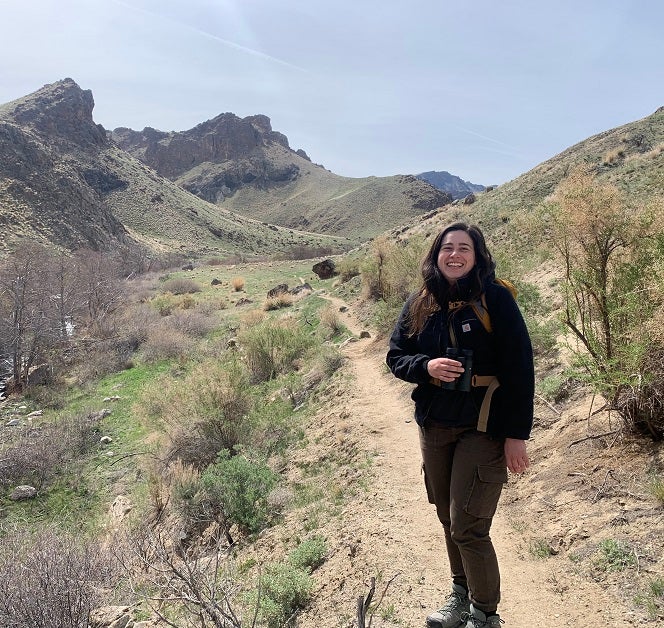
Boise State University MS Raptor Biology student Ashley Santiago defended her thesis, “Associations Between Landscape Changes And Declines In Golden Eagle Territory Occupancy In The Morley Nelson Snake River Birds Of Prey National Conservation Area” on the morning of April 19, 2024. Santiago’s main advisor is Julie Heath (MS, Raptor Biology, ’96; Boise State University Raptor Research Center, Biological Sciences), and her committee includes Jen Cruz (Boise State University Raptor Research Center, Biological Sciences) and Donna Delparte (Boise State University Biological Sciences).
ABSTRACT
Rapid loss of native shrubs and expansion of invasive annuals like cheatgrass (Bromus tectorum) have extensively altered shrub-steppe systems. Vegetation changes can have bottom-up effects on trophic interactions and ecosystem dynamics. Predators, like Golden Eagles (Aquila chrysaetos) that forage on shrub-reliant prey, may increase their territory size to cope with degraded habitat or abandon historically occupied territories sites. We used a multi-season occupancy model that accounted for imperfect detection to investigate the associations between landscape cover (i.e., shrub and annual herbaceous), fire history, neighbor density, and eagle territory occupancy of 36 Golden Eagle nesting territories in the Morley Nelson Snake River Birds of Prey National Conservation Area (NCA), Idaho, USA from 1986–2022.
The probability of Golden Eagle occupancy decreased 23% from 0.82 in 1986 to 0.59 in 2022. Further, once territories became vacant, they tended to remain vacant, suggesting that the territories were no longer suitable for eagles or no new eagles were recruiting into the population. Territory occupancy was negatively associated with annual herbaceous cover (β: -0.86, 95% CI: -1.53 to -0.24) and tended to be positively associated with shrub cover (β: 0.63, 95% CI: -0.11 to 1.39) and time since last burn (β: 0.25, 95% CI: -0.28 to 0.83). Territories that were farther from other occupied territories had a higher probability of occupancy than territories with closer neighbors (β: -3.56, 95% CI: -4.22 to -2.92), likely because as habitat degraded, eagles compensated by expanding their territories into nearby vacant territories. The probability of detection was high at 0.90 but improved in surveys conducted earlier in the day and later in the breeding season.
Together, these results show that landscape change and habitat degradation have bottom-up effects on Golden Eagle behavior and territory occupancy, resulting in an overall decrease in the local carrying capacity for eagles. Understanding associations between environmental change and territory occupancy has important implications for predicting population persistence and eagle adaptability to changing landscapes.